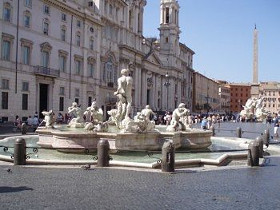 Fundamental stone at the origin of Western Civilizations, Rome is located on the Italian peninsula, within the region called Lazio, and is the capital of Italy. Located in the valley of the River Tiber, it is a few kilometres from the magical Tyrrhenian Sea. Because of its historical heritage, monuments and legends, it is now a must for tourists who choose Europe as their destination. In this sense, the traditional plans offer to visit the Colosseum, the Trevi Fountain, the Vatican (especially the Sistine Chapel) and the Plaza de San Pedro.
Fundamental stone at the origin of Western Civilizations, Rome is located on the Italian peninsula, within the region called Lazio, and is the capital of Italy. Located in the valley of the River Tiber, it is a few kilometres from the magical Tyrrhenian Sea. Because of its historical heritage, monuments and legends, it is now a must for tourists who choose Europe as their destination. In this sense, the traditional plans offer to visit the Colosseum, the Trevi Fountain, the Vatican (especially the Sistine Chapel) and the Plaza de San Pedro.
For those who travel this city, rich at all levels, it is necessary to emphasize that the hotels in Rome offer a wide variety and adaptation to the resources of the traveler. The same is true of gastronomy which, in addition to proposing the typical of the area and the country (pasta and pizzas, for example), has a wide range of options as far as cooking is concerned.
The most recognized Roman symbol in the world is undoubtedly the Colosseum. This imposing construction was carried out between the year 70 and the 72 A.D., at the time of the Emperor Vespasiano, and was used for approximately 500 years. One of its most spectacular attributes for the time was the possibility of hosting 50,000 people, a figure that even today many stadiums do not reach. Originally, there were battles between gladiators, plays and various activities. Thousands of visitors arrive each year to enter, contemplate and know the museum dedicated to the Greek god Eros, which works on the upper floor of the building.
Other of the main attractions of Rome are the Trevi Fountain, built from the discovery of a spring and created at the foot of an aqueduct, near the year 19 B.C.; And the Vatican, an independent state located in the center of the city that gives tourism a unique opportunity to rub shoulders with the most dazzling architectural and artistic works on the planet, like the Basilica of St. Peter (in the mythical plaza of the same name) and the Sistine Chapel, one of Michelangelo’s sublime works.
The historic centre, declared a World Heritage Site by UNESCO in 1980, the Plaza España and infinite churches, more squares and even nightlife. It is all part of the charm of Rome, in a place where the roots of the ancient empire are still perceived when walking. As long as the time has been stopped.
